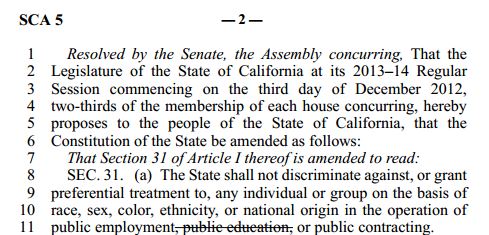When my brother in-law told me how his fellow Asian realtors were upset about a proposed law to limit Asian enrollment in California colleges, I was initially skeptical. A law to put a cap on Asian students? But after looking at an e-mail (shown below) about that proposal that he forwarded me and doing a little research, there seemed to be something to this. State Constitutional Amendment 5 (SCA5) looks to change California’s Proposition 209, which eliminated affirmative action in the state, to once again allow racial preferences in public education. If approved by the California Assembly (it’s already approved by the State Senate), this proposal will go to California voters for approval. Some groups have reacted by putting up a petition at change.org and another at whitehouse.gov.
SCA5 has a lot of work ahead of it to pass, even if it passes the state Assembly and goes before the voters. There is no guarantee that it will be passed, although a study has shown many white Californians think test scores are less important after they hear about Asian successes in the University of California. Even if SCA5 is approved by California voters, it is sure to be challenged in the court.
Still, I find this whole discussion frustrating for a number of reasons. Some Asian ethnic groups (like mine) saw their numbers drop off after Proposition 209. Still, allowing racial preferences for what people say are the “right” reasons also allows for racial preferences for the wrong reasons. The amendment also doesn’t do what really needs to be done to increase black and Hispanic graduates from California colleges in the long term – increase the quality of K-12 education for everyone. That discussion seems to be largely absent from both proponents and opponents of the amendment.
There is also the assumption that college admissions are a zero sum game. As the population of California continues to increase, there needs to be an increase the number of slots for affordable college education. Otherwise, with constant budget pressures and a fixed number of slots, even with affirmative action, ethnic groups would simply be fighting over a shrinking number of slots for state residents as colleges have incentives to grant slots to out of state students and international students who can pay full price. You can see this already happening with admissions “holistic review“.
Below is the text of the e-mail advocating the anti-SCA5 petition that my brother in-law sent me:
——– Original Message ——–
Subject: About SCA5 and Say no to SCA5
http://www.change.org/petitions/california-state-assembly-vote-no-to-sca-5?share_id=GIZcXqiiUf&utm_campaign=share_button_action_box&utm_medium=facebook&utm_source=share_petition
Please forward this to your friends who may concern:I just signed the petition “California State Assembly: Vote NO to SCA 5!” on Change.org.
It’s important. Will you sign it too? Here’s the link:
I would be cautious about using the conclusion from the article: http://www.nyu.edu/projects/care/docs/CARE-Brief-raceblind_v3TLKN-OAP.pdf (“These results demonstrate that the rate of admissions for AAPIs, the number of admitted AAPIs over the number of AAPI applicants, has actually decreased since the UC system changed to a race-blind admissions policy.”).
A close look at the raw data (http://data.universityofcalifornia.edu/student/admissions/data-tables/Freshman-Applicants-Admits-Enrollees-by-Campus-Ethnicity-Fall-1994-2010.pdf) would indicate that the asian admit rate stays roughly the same compared to the overall admit rate given a certain year, although the asian admit rate has gone down over the years (because of the increase in applicant pool and decrease in overall admission rate). For example:
UCLA-
In 1994:
Asian American 9,544 (applicants) 4,687 (admits) 1,724 (enrollees) 49.1% (admit rate) 36.8% (yield rate)
African American 1,241 713 280 57.5% 39.3%
Chicano/Latino 3,479 2,026 741 58.2% 36.6%
Total 23,557 11,801 4,125 50.1% 35.0%In 2008:
Asian American 19,301 4,831 1,723 25.0% 35.7%
African American 2,826 452 230 16.0% 50.9%
Chicano/Latino 10,286 1,683 750 16.4% 44.6%
Total 55,423 12,659 4,734 22.8% 37.4%In other words, overall it has been made more difficult to get into UC because more applicants are applying now than before. So only looking at the decrease in Asian admit rate is not sufficient.








